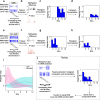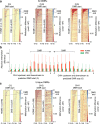HOME: a histogram based machine learning approach for effective identification of differentially methylated regions
- PMID: 31096906
- PMCID: PMC6521357
- DOI: 10.1186/s12859-019-2845-y
HOME: a histogram based machine learning approach for effective identification of differentially methylated regions
Abstract
Background: The development of whole genome bisulfite sequencing has made it possible to identify methylation differences at single base resolution throughout an entire genome. However, a persistent challenge in DNA methylome analysis is the accurate identification of differentially methylated regions (DMRs) between samples. Sensitive and specific identification of DMRs among different conditions requires accurate and efficient algorithms, and while various tools have been developed to tackle this problem, they frequently suffer from inaccurate DMR boundary identification and high false positive rate.
Results: We present a novel Histogram Of MEthylation (HOME) based method that takes into account the inherent difference in the distribution of methylation levels between DMRs and non-DMRs to discriminate between the two using a Support Vector Machine. We show that generated features used by HOME are dataset-independent such that a classifier trained on, for example, a mouse methylome training set of regions of differentially accessible chromatin, can be applied to any other organism's dataset and identify accurate DMRs. We demonstrate that DMRs identified by HOME exhibit higher association with biologically relevant genes, processes, and regulatory events compared to the existing methods. Moreover, HOME provides additional functionalities lacking in most of the current DMR finders such as DMR identification in non-CG context and time series analysis. HOME is freely available at https://github.com/ListerLab/HOME .
Conclusion: HOME produces more accurate DMRs than the current state-of-the-art methods on both simulated and biological datasets. The broad applicability of HOME to identify accurate DMRs in genomic data from any organism will have a significant impact upon expanding our knowledge of how DNA methylation dynamics affect cell development and differentiation.
Keywords: DMR identification; DNA methylation; Epigenetics; SVM; Whole genome bisulfite sequencing.
Conflict of interest statement
Ethics approval and consent to participate
Not applicable.
Consent for publication
Not applicable.
Competing interests
The authors declare no conflicts of interest.
Publisher’s Note
Springer Nature remains neutral with regard to jurisdictional claims in published maps and institutional affiliations.
Figures






Similar articles
-
Defiant: (DMRs: easy, fast, identification and ANnoTation) identifies differentially Methylated regions from iron-deficient rat hippocampus.BMC Bioinformatics. 2018 Feb 5;19(1):31. doi: 10.1186/s12859-018-2037-1. BMC Bioinformatics. 2018. PMID: 29402210 Free PMC article.
-
Detection of differentially methylated regions in whole genome bisulfite sequencing data using local Getis-Ord statistics.Bioinformatics. 2016 Nov 15;32(22):3396-3404. doi: 10.1093/bioinformatics/btw497. Epub 2016 Aug 4. Bioinformatics. 2016. PMID: 27493194
-
Cord blood DNA methylome in newborns later diagnosed with autism spectrum disorder reflects early dysregulation of neurodevelopmental and X-linked genes.Genome Med. 2020 Oct 14;12(1):88. doi: 10.1186/s13073-020-00785-8. Genome Med. 2020. PMID: 33054850 Free PMC article.
-
Methods for identifying differentially methylated regions for sequence- and array-based data.Brief Funct Genomics. 2016 Nov;15(6):485-490. doi: 10.1093/bfgp/elw018. Epub 2016 Jun 20. Brief Funct Genomics. 2016. PMID: 27323952 Review.
-
Methods in DNA methylation array dataset analysis: A review.Comput Struct Biotechnol J. 2024 May 17;23:2304-2325. doi: 10.1016/j.csbj.2024.05.015. eCollection 2024 Dec. Comput Struct Biotechnol J. 2024. PMID: 38845821 Free PMC article. Review.
Cited by
-
Embryonic Stem Cell-Derived Neurons as a Model System for Epigenome Maturation during Development.Genes (Basel). 2023 Apr 22;14(5):957. doi: 10.3390/genes14050957. Genes (Basel). 2023. PMID: 37239317 Free PMC article.
-
MethylC-analyzer: a comprehensive downstream pipeline for the analysis of genome-wide DNA methylation.Bot Stud. 2023 Jan 6;64(1):1. doi: 10.1186/s40529-022-00366-5. Bot Stud. 2023. PMID: 36607439 Free PMC article.
-
The emerging role of cell-free DNA as a molecular marker for cancer management.Biomol Detect Quantif. 2019 Mar 18;17:100087. doi: 10.1016/j.bdq.2019.100087. eCollection 2019 Mar. Biomol Detect Quantif. 2019. PMID: 30923679 Free PMC article. Review.
-
Whole-genome methylation analysis reveals epigenetic variation between wild-type and nontransgenic cloned, ASMT transgenic cloned dairy goats generated by the somatic cell nuclear transfer.J Anim Sci Biotechnol. 2022 Nov 25;13(1):145. doi: 10.1186/s40104-022-00764-6. J Anim Sci Biotechnol. 2022. PMID: 36434676 Free PMC article.
-
Uncovering Alterations in Cancer Epigenetics via Trans-Dimensional Markov Chain Monte Carlo and Hidden Markov Models.bioRxiv [Preprint]. 2023 Jun 15:2023.06.15.545168. doi: 10.1101/2023.06.15.545168. bioRxiv. 2023. PMID: 37398181 Free PMC article. Preprint.
References
-
- Richardson BC. Role of DNA methylation in the regulation of cell function: autoimmunity, aging and cancer. J Nutr. 2002;132(8):2401S–2405S. - PubMed
-
- Khavari DA, Sen GL, Rinn JL. DNA methylation and epigenetic control of cellular differentiation. Cell Cycle. 2010;9(19):3880–3883. - PubMed
-
- Jones PA. Functions of DNA methylation: islands, start sites, gene bodies and beyond. Nat Rev Genet. 2012;13(7):484–492. - PubMed
MeSH terms
Grants and funding
LinkOut - more resources
Full Text Sources
Other Literature Sources
Molecular Biology Databases

